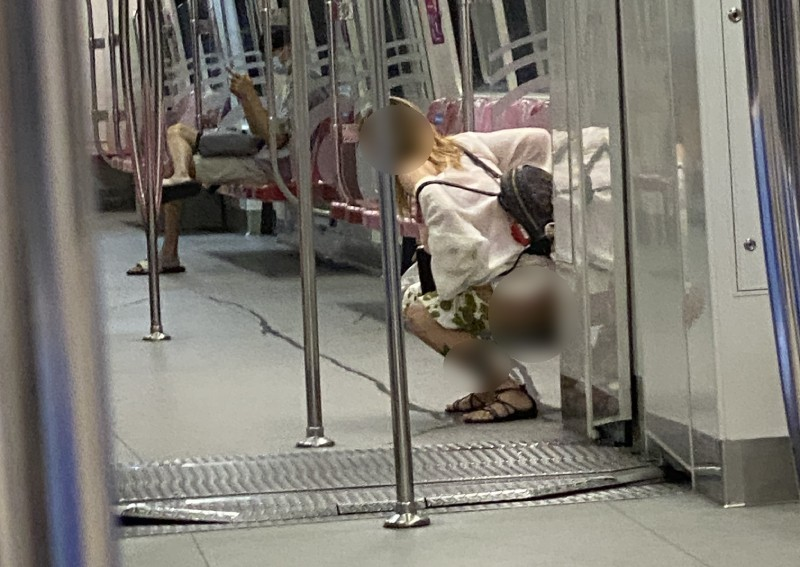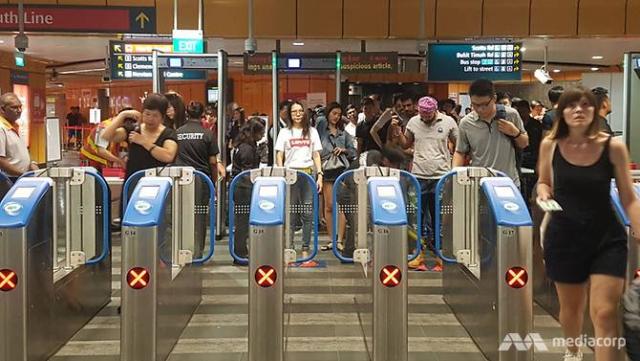Search the Community
Showing results for tags 'mrt'.
-
I have locked the old thread (ALL consolidated SMRT/NEL/KT.. simisai BREAKDOWNS here!) as it is getting to large (>10,800 posts). Please continue the discussion here, on matter relating to mantenance and breakdown of MRT & LRT network. On discussion of management and other administrative matters, please post it under the Change in SMRT CEO (Apr 2018), Management & Other Matters. 4 current / standing announcements by SMRT and SBS Transit as follow: Early Closure/Late Opening of MRT stations along the North-South Line in May 2018 for Maintenance and Improvement Works Affected Stations Alternate Transport Services Bukit Panjang LRT to close every Sunday from 15 April to 24 June for Planned Maintenance Work SMRT will be carrying out planned maintenance work on the Bukit Panjang Light Rail Transit (BPLRT) every Sunday from 15 April to 24 June 2018. As such, there will be no LRT services on Sundays during this period. In lieu of LRT train services on these 11 Sundays, shuttle buses which run parallel to the BPLRT network will be available (Refer to Annex A) for commuters as an alternative travel option. This is in addition to the existing bus services which already serve the Bukit Panjang town. Alternative Travel Options Stations along the East-West Line will continue to close earlier, open later on April weekends All 35 MRT stations along the East-West Line (EWL) from Tuas Link to Pasir Ris, and from Tanah Merah to Changi Airport, will continue to close earlier and open later for all weekends in April 2018. Appendix A - Last train timings on the East-West Line on Fridays and Saturdays for April 2018 - First train timings on the East-West Line on Saturdays and Sundays for April 2018 Appendix B - Shuttle Bus and Express Bus Services Operational when MRT stations Close Early or Open Later for April 2018. Appendix C - Alternative Travel Plans for Shortened Operating Hours on EWL from 2 March to 29 April 2018 Extension of service hours for 14 bus services due to EWL Maintenance Works The operating hours of 14 SBS Transit bus services - Services 51A, 60A, 63M, 181, 222, 225G, 228, 229, 240, 241, 243G, 291, 292 and 293 - will be extended to 1.30am on Fridays and Saturdays in the month of April due to the early closure of all 35 stations along the East-West Line (EWL) from Tuas Link to Pasir Ris and from Tanah Merah to Changi Airport. Appendix - Last Bus Timings on Fridays and Saturdays in April 2018
-
Public transport fare hike: Adults to pay 10 to 11 cents more per journey from Dec 23 The Public Transport Council, which regulates bus and train fares, has granted an overall increase of 7 per cent as part of the 2023 fare review exercise. SINGAPORE: The latest bus and train fare increases will more than double from last year's hike, which means adult commuters will pay 10 to 11 cents more per journey, the Public Transport Council (PTC) said on Monday (Sep 18). The PTC, which is the Singapore regulator for public transport fares, announced an overall fare increase of 7 per cent following the annual fare review exercise. The fare hikes will take effect on Dec 23. The trend of sharper increases could potentially continue with the PTC again deferring a bulk of the fare adjustment quantum to future fare review exercises. This year's fare review exercise is the first under the new formula announced in April, which the PTC had said was aimed at keeping fares affordable and less volatile. As part of the review - conducted every five years - the fare formula was adjusted to include two fixed components to reduce swings in fare changes. Adult card fares will increase by 10 cents for up to 4.2km and 11 cents for distances above that, while adult cash fares - used for bus rides - will increase by 20 cents. Adult monthly travel passes will remain at S$128. The 11-cent increase is the highest, according to the PTC, which pointed out that 2019 also saw a 7 per cent increase in fares, but from a lower base. A lower increase will be implemented for concession card fares for students, seniors, low-wage workers and people with disabilities. Fares in this category will go up by 4 to 5 cents per journey, depending on the distance travelled. Concessionary cash fares for bus rides will increase by 10 cents. In all, commuters with concessions account for about two million, or half of Singaporeans. Heavy public transport users who belong to concessionary groups, such as students, seniors, and full-time National Servicemen, will see prices of hybrid monthly concession passes reduced by 10 per cent. The price of monthly concession passes for people with disabilities will be reduced from S$64 to S$58, similar to that of seniors. Lower-wage workers will be able to use a new workfare transport hybrid monthly concession pass priced at S$96. BULK OF FARE ADJUSTMENT DEFERRED TO FUTURE EXERCISES The fare increase for the fare review exercise 2022 was 2.9 per cent, with adult card fares increasing by 4 to 5 cents per journey. This year's increase of 7 per cent is only a portion of the maximum allowable fare adjustment quantum of 22.6 per cent, comprising of last year's deferred increase of 10.6 per cent and this year's 12 per cent. PTC chair Janet Ang said that the council had decided not to grant the full allowable fare adjustment of 22.6 per cent to keep public transport fares affordable in the higher cost environment, fueled by core inflation, strong wage growth, and a hike in energy prices. The increase of 7 per cent means that the remaining 15.6 per cent will be deferred to future fare review exercises. "If we had done the full maximum allowable fare increase of 22.6 per cent, it will translate to about 30 cents per journey for all commuters," PTC chief executive Tan Kim Hong told reporters at a press conference on Monday. Asked if the rolled-over numbers indicated more fare hikes in the next few years, Mr Tan said: "Yes." He added: "What is important is over the next few years - how does the council then decide what is the number that we should put up where by it still balances both the commuters and the taxpayers?" The council was also asked what the maximum allowable increase would have been if the old fare formula from 2018 to 2022 had been applied. Mr Tan replied that the old formula should not be used due to the current operating environment, which has changed. "The formula itself has been updated this year to reflect the latest operating environment. "You should not look back into the past formula, because the past formula itself was designed based on the operating environment, which has changed drastically." For example, Mr Tan said ridership has yet to recover to pre-pandemic levels, which would have affected the capacity component - known as the network capacity factor - of the old formula. The network capacity factor tracks operating costs due to network capacity changes relative to ridership. It has been replaced by a capacity adjustment factor in the new formula, and has been fixed at 1.1 per cent for the next five years to reduce variability resulting from capacity and ridership changes. Reiterating Mr Tan's point, Ms Ang said: "If you really go and calculate based on the old formula, the number will be out of the chart. Therefore, it validates again that the new fare formula law is intended to reduce the volatility of fare increases for commuters." To cover the deferred fare adjustment quantum, the PTC requested that the government provide an additional subsidy of about S$300 million for this year's fare review exercise - higher than the S$200 million provided after last year's fare review exercise. The government has agreed to this subsidy, said PTC. In tandem with the higher fare increase, the PTC will also require operators SBS Transit and SMRT Trains to make a larger contribution towards the Public Transport Fund. For this year, SBS Transit and SMRT Trains should contribute 15 per cent and 30 per cent of their expected increase in revenue respectively to the fund. This will come up to a total of S$15.85 million. The PTC has recommended that the government draw on the fund to provide further assistance to the lower-income resident households in the form of public transport vouchers. https://www.channelnewsasia.com/singapore/mrt-bus-fare-increase-10-11-cents-public-transport-council-3779086
- 317 replies
-
- 3
-

-
.png)
-
- public transport
- bus
-
(and 1 more)
Tagged with:
-
The 1987 trains in operation since MRT was a thing will be retired. The first two new trains for the North-South and East-West MRT lines (NSEWL) have arrived in Singapore. Source: https://mothership.sg/2022/02/new-mrt-trains-replace-1987-fleet/ They are part of a fleet of 106 new trains designed in Germany and built in China. The trains were shipped to Singapore by sea. The journey took about one month to complete. Details about the new trains were shared by the Land Transport Authority (LTA) on Facebook on Feb. 21. Replace trains in use since 1987 The new rolling stock will replace trains that have been operating on the two lines since 1987 when the NSEWL began operations. The first-generation trains will be retired when the new trains enter service from the end of 2022. The new trains also highlight how the supply chain spans many countries in the northern hemisphere. “The design was conceptualised in Germany before they were manufactured and assembled in China, and their parts were sourced from various countries including United Kingdom, France and Germany,” LTA wrote. Decked out in green and red stripes, the traditional colours of NSEWL, they will serve commuters from end-2022, LTA added. The trains will undergo rigorous testing and commissioning works before they are ready. Standardised look In 2018, LTA announced that it had bought 66 new trains to replace its oldest fleet. The trains were to be made by Canadian company Bombardier Transportation, and were supposed to arrive in batches from 2021. In 2020, it was announced that a second set of 40 trains were to be bought from Bombardier to replace second- and third-generation trains on the North-South and East-West lines from 2024. The 19 second-generation trains have been operating since 1995. The 21 third-generation trains have been in service since 2000. A total of 198 trains of six different types serve the NSEWL as of 2020. In contrast, all 106 new trains will have the same design.
-
First case, at Outram Park: https://www.channelnewsasia.com/singapore/public-urination-outram-park-mrt-escalator-handrail-viral-video-man-fined-li-guorui-4857001 Second case, at Tanah Merah: https://www.straitstimes.com/singapore/police-investigating-man-who-allegedly-urinated-in-public-at-tanah-merah-mrt-station Third case, at Potong Pasir: https://www.channelnewsasia.com/singapore/man-arrested-public-urination-incident-potong-pasir-mrt-station-4857766 Outram Park, Tanah Merah, Potong Pasir.. They trying to get an OTP? 😅
-
https://www.straitstimes.com/singapore/transport/two-new-mrt-stations-for-north-south-line-by-mid-2030s-potential-new-rail-line Why government hate the west so much? I really thought the next line will be serving the west to city.
-
After having lived with it for two decades, I no longer question it: Any trip towards Punggol MRT, and out of the estate, requires me to take the LRT first. I’ve always known at the back of my head that my estate is sort of a special one-out-of-three. (Or three-and-a-half.) Only Sengkang and Bukit Panjang also have full LRT loops, while the latter also has a single-line that connects to Choa Chu Kang MRT station. But since I’ve been relatively shielded from the woes of commuters on the other end of Singapore, I never realised how badly planned out the LRT system in Bukit Panjang was. This video that I had saved in my 'Watch Later' playlist for more than a year (I'm the worst at procrastinating when it comes to my own interests and hobbies...) goes into all of the issues in a really engaging and witty manner. Mostly, a lot of criticism over the years has been directed at the fact that the system was built as an afterthought to an estate that had already been independently developed - rather than integrated into its design from the start. Reliability woes didn’t help, and in all, it seems that a lot of money has been sunk into its upkeep over the years. I'll be the first to say that I'm no public transport or urban planning expert. As such, I don't really have anything meaningful to add to the video except for the fact that there were a couple of interesting concepts that really caught my attention: 1) “Access penalty” In explaining why he thinks buses may be superior, the video creator brings up the point of an ‘access penalty’, which refers to the time required to get from the station entrance to the vehicle. As a regular LRT-taker, I’ve never quite been able to put into words the reason why taking the bus is just an overall more comfortable experience, but I feel like this concept does it quite well. Bus stops impose virtually no access penalty on commuters - you simply get onto the bus (Image credit: Unsplash/isaac.) Because LRT stations are elevated quite high up, quite a fair bit of climbing and descending is required with any trip. It’s actually worse for those with mobility issues because the lifts on my line somehow operate slower than the average ones - and you need to take two of them separately to finally reach the platform level. On days when I’m simply too exhausted after work and there’s no proper ‘reporting time’ for getting home, I prefer just waiting for the bus at the interchange. 2) The LRT is technically not ‘light rail’-like Light rail is conventionally understood to have two characteristics. It’s a) surface-level, and 2) ‘Steel on steel’, or steel wheels on steel rails. Our LRT trains, you’ll notice, are rubber-tyred - and of course, very far off the ground. As such, the video creator goes on to make the argument that there's been some level of mis-branding with what we know as the LRT today. Manchester's trams are an example of what light-rail is technically supposed to look like (Image credit: Unsplash/Hala AlGhanim) And finally, as a third, not-video-related surprising fun fact that surfaced as I was digging down this rabbit hole... 3) Singapore almost got a fourth LRT line I also learned that the government initially intended to build another LRT line in the Western part of Singapore, to connect NTU to Jurong East. It has since apparently been canned, with the route subsumed (or expanded, depending on how you think about it) into the Jurong Regional Line, which will be a proper MRT line. Putting things into context Again, I think a lot of the criticism towards LRTs in Singapore is isolated within the Bukit Panjang area, which the video in question - and also the following one that gives a quicker but no less effective overview - make sure to caveat. Sengkang and Punggol both had their LRT systems conceptualised within their town plans for day one - and so, these have been far less problematic (although they also remain notoriously difficult to navigate for first-timers). In their defence - and as daily LRT-commuter, there’s also one good reason why I choose to take the LRT instead of the bus route running parallel to the MRT station (62) no matter what: Regularity. Since our LRTs are automated and programmed according to regular intervals, you know for sure that the next ‘train’ will arrive by a certain time even if you’ve seen it just depart when you reach the platform. It does remain intriguing nonetheless that the LRT model hasn’t been replicated anywhere else in Singapore, despite the fact that new estates continue to be sprouting up. Thoughts on what else Singapore can do to better its last-mile public transport support? - Matt (Cover image credit: Unsplash/Jeyakumaran Mayooresan)
- 1 comment
-
- public transport
- lrt
- (and 4 more)
-
@Enderone no happy ending 🤣
-
Ever seen a guide dog when taking the MRT or public buses? If you've not, you're not alone - it's not a common sight here in Singapore, as I've gathered. Most of my friends and colleagues whom I spoke to echoed the same observation. This was interesting to me since guide dogs are literally entitled to taking public transport. In fact, I saw the first guide dog in my life while commuting via the Circle Line just the other day. As a dog lover, I was pleasantly surprised to see the Golden Retriever riding on the same train as I was. Patiently, it guided its visually impaired friend from one platform to the other, and up and down escalators. Along the way, commuters looked unsure about what to do, except to make way when the duo came along. And then it dawned on me: How well do we know the Guide Dog Laws in Singapore? What should we do if and when we cross paths with a guide dog? The Guide Dog Law in Singapore First, let's talk about the law. Animals are legally not allowed on public transport. But guide dogs can, as long as they are accompanying a person with visual or hearing impairment. This exception extends to all trains and buses in Singapore. There's also religious guidance from the Majlis Ugama Islam Singapura (MUIS) to allay any concerns that our Muslim community may have in relation to sharing the use of public spaces with guide dogs. How to identify a guide dog Guide dogs are easily recognisable. When at work, guide dogs wear a yellow tag around their necks that say: "Do not Distract. Guide Dog at Work." If I may add though, guide dogs - or at least the one that I had the chance to meet - are so at peace that they can be such a calming existence to be around 😊 How can you help? You might be excited or afraid to see a guide dog at the train station or bus interchange. These are natural reactions especially towards things you don’t normally see in your day-to-day life. But calm your heart and keep in mind these five things advised by Guide Dogs Singapore: Do not distract a guide dog on duty Do not feed the guide dog Offer assistance from the side opposite the guide dog, if requested by the guide dog user Always speak to the guide dog user When approaching obstacles, allow the guide dog team to proceed first before joining them on the other side Remember that guide dogs have duties to perform and the least we can do is to help them execute their duties immaculately. That way, we enable independent exploration for Persons with Disabilities so they are able to move around more freely and with greater confidence. So the next time you come across a guide dog, you know what to do! I'll leave you to enjoy this video, which definitely explains way better than I do, the difference you can make just by being aware 🥰 – Denise P.S.: Refrain from giving the guide dog a friendly pat no matter how endearing it is to you 🙂 (I promise I won't too!) Photos and video from: Guide Dogs Singapore
-
Japanese city Nagoya bans walking on escalators NAGOYA, Japan – A Nagoya city ordinance requiring people to stand on escalators rather than walk on them went into effect on Sunday. In Nagoya, it is customary to stand still on the left side of the escalator and leave the right side free for people who want to walk up or down. The challenge now is how to let commuters know about the ordinance and enforce it to prevent accidents such as falls. Japan Today reported that in recent years, there have been many incidents of people losing their balance and knocking others over, as well as accidents involving commuters running up and down the escalators. The ordinance requires people to stand still on any escalator at train stations and other facilities in the city, regardless of whether they stand on the left or right. However, there are no penalties for breaking the rule. The Nagoya City government has been running TV commercials and putting up posters about the new ordinance at major train stations, reported Japan Today. Nagoya is not the first city to adopt this move. The Saitama prefectural government was the first in the country to enforce a similar ordinance in October 2021. A study found that at one point, enforcement decreased the percentage of people walking on escalators from 60 per cent to 38 per cent, but it has now returned to the pre-ordinance level. https://www.straitstimes.com/asia/east-asia/japanese-city-nagoya-bans-walking-on-escalators we should adopt too : - older stations like Orchard (NSL side), Dhoby Ghaut (NSL side) can't clear commuters from platform timely and safely during peak hours - some newer stations have very long escalators (eg Stadium, Jalan Besar) and its really not safe to walk on down riding escalator
-
Bus, train fares to increase by up to 5 cents due to rising energy costs: Public Transport Council From Dec 26, adult card fares will increase by 4 cents for journeys of up to 8.2km. For journeys longer than 8.2km, fares will increase by 5 cents. SINGAPORE: Bus and train fares in Singapore will increase by up to 5 cents from Dec 26 due to rising energy prices, the Public Transport Council (PTC) announced on Wednesday (Oct 12) after its annual fare review exercise. Adult card fares will increase by 4 cents for journeys of up to 8.2km and 5 cents for journeys longer than 8.2km. This means that an MRT journey from Boon Lay to Clementi, where the distance is 8.2km, will be S$1.45 for adult commuters, up from S$1.41 currently. Taking the MRT from HarbourFront to Paya Lebar, where the distance is 11.5km, will cost S$1.64, up from S$1.59. Based on travel data, about 54 per cent of adult journeys are less than 8.2km, said the PTC. The increase in concession card fares will be capped at 1 cent per journey to keep fares lower for students, senior citizens, lower-wage workers and people with disabilities, said the PTC. Prices of monthly concession passes and adult monthly travel passes will remain unchanged. Bus cash fares will also stay the same, for the third year in a row since 2019. To help lower and lower-middle income households – those with a monthly household income per person of up to S$1,600 – the Government will give out 600,000 public transport vouchers worth S$30 each, which can be used to top up fare cards or buy monthly concession passes. RISING ENERGY, LABOUR COSTS The fare hike is necessary to meet rising energy prices, which rose by 117 per cent last year, the PTC said. Coupled with increased manpower costs and inflation, this led to a maximum allowable fare adjustment quantum of 13.5 per cent according to PTC’s fare adjustment formula. This is the highest quantum generated by the fare formula since it was implemented in 2005. However, the PTC said it decided to grant public transport operators a fare increase of just 2.9 per cent due to concerns over the rising cost of living. The remaining 10.6 per cent will be carried over to future fare review exercises. About 1.8 per cent of household income goes to public transport for an average user, according to the public transport affordability indicator, which is based on data from the Department of Statistics. With this year's fare hike, and taking into account average wage increases, the PTC said the monthly public transport expenditure for these households is expected to remain at a similar level. At a press conference on Wednesday, PTC chairperson Janet Ang said the council looks at both the economic situation as well as the percentage increase generated by the fare formula. “We will digest it together as a community,” she added. Transport Minister S Iswaran said in a Facebook post after the announcement that "fare adjustments are never easy". "To keep our public transport system financially sustainable, fares need to be updated to cover the increased costs," he wrote. The Government will cushion the impact with public transport vouchers, concession schemes and subsidies, and ensure that fares remain affordable especially for the vulnerable, he added. As of last month, public transport ridership has recovered to about 80 per cent of pre-pandemic levels, said the PTC. Last year, bus and train fares in Singapore increased by up to 4 cents, after the council decided to grant the maximum allowable fare adjustment quantum of 2.2 per cent to help operators mitigate the costs of running public transport services. This came amid rising operating costs and a drop in ridership due to the COVID-19 pandemic. It marked the first fare increase since 2019, when fares were increased by 7 per cent, or 9 cents per journey, for adult commuters using travel cards. During its 2020 fare review exercise, the PTC decided against raising public transport fares due to the COVID-19 crisis and its impact on the economy. CALCULATING FARE ADJUSTMENTS In August, the PTC announced that it was in the midst of reviewing the way bus and train fare adjustments are calculated. The review of the formula and mechanism for adjusting public transport fares is slated to be completed by the first half of next year. Any change will be applied from the 2023 fare review exercise. Typically conducted every five years, it aims to examine the effectiveness of the current fare adjustment formula and mechanism, taking into account changes in the public transport industry and commuting patterns. PTC also said then that it would propose means to better maintain the balance to keep public transport fares affordable while ensuring the financial sustainability of the public transport system. https://www.channelnewsasia.com/singapore/public-transport-fares-bus-train-increase-adult-5-cents-energy-costs-3003941 Merry Christmas !
- 123 replies
-
- 4
-

-
Public transport or public toilet? Woman pulls down shorts to pee on MRT train https://www.asiaone.com/singapore/public-transport-or-public-toilet-woman-pulls-down-shorts-pee-mrt-train?utm_medium=Social&utm_source=Facebook&fbclid=IwAR116dxDQIu0fQ9yQqctjgdQRM7cIoBZ2xb_dKKmhjep_avSoHXiDrO-JEM#Echobox=1661914014 AUGUST 31, 2022 PUBLISHED AT 10:30 AM By MELISSA TEO The woman urinating on the floor. AsiaOne/Melissa Teo This incident took place on Monday (Aug 29) at around 12.35 am on a North-South line train headed towards Jurong East MRT station when AsiaOne witnessed a woman, who seemed to be intoxicated, lying flat across three train seats. As the train was travelling between Choa Chu Kang and Bukit Gombak MRT stations, this woman, who looks like she is in her late 20s, suddenly stood up and stumbled her way across three train cabins, leaving one of her bags behind. She did not have a mask on and was coughing violently. When she reached the third cabin, she went to one of the corner seats, pulled down her shorts and squatted to pee, to everyone's horror. One passenger in that cabin immediately stood up and left for the next cabin when he saw her doing so. The stream of pee could be seen trickling down the cabin floor towards the front of the train. After that, the woman got off at Jurong East MRT station and decided to sit on the escalator steps heading down – only budging when a kind man offered to help her up at the end of the escalator. When contacted by AsiaOne, SMRT advises commuters to report any suspicious behaviour, bags or packages immediately to their staff. For complaints, general enquiries and feedback, commuters may contact the SMRT hotline at 1800-336-8900 from 7.30 am to 8 pm daily or via its feedback form. According to the Environmental Public Health (Public Cleansing) Regulations, it is an offence to urinate or defecate "in or upon any street, arcade, vacant land, river, canal, ditch, drain or watercourse or in any place to which the public has access except in any sanitary convenience provided for such purpose". The penalty is a fine of up to $1,000 for the first offence, and up to $2,000 and $5,000 for the second and third offences respectively. This isn't the first time someone has urinated in public. In July, a woman was caught on camera taking a leak outside Northpoint City and also witnessed by a number of passers-by. After she was done, the woman walked away nonchalantly.
- 59 replies
-
- 12
-

-

-

-

-
.png)
-
https://www.straitstimes.com/singapore/sbs-transit-apologises-for-outdated-hari-raya-aidilfitri-greetings-on-mrt-train Honest mistake.
-

Man brings bicycle aboard MRT, proceeds to shout expletives at commuters
chitchatboy posted a blog entry in MyAutoBlog
Ever seen one of these foldable bicycles? The guy below probably has not. Now, this might not be very useful information (because it is not allowed) but apparently, our local train's railing can support a non-foldable bicycle. We thought it is an ingenious way to park or store one away. For those who are wondering what on earth is happening, below is an extract replicated from SMRT... "Some of you may have come across a video that is circulating online about a commuter with a bicycle on board a train. At around 7.10pm on 15 Dec, an SMRT staff tried to stop a male commuter with a non-foldable bicycle from entering the train at Woodlands station. The male commuter was uncooperative and forced his way into a north-bound train. The commuter subsequently transferred to a west-bound train at Jurong East station and exited at Pioneer station at about 7.50pm. We have since identified the commuter and made a police report. For the safety and comfort of all commuters, we would like to remind everyone to observe regulations when bringing foldable bicycles and personal mobility devices on board trains and buses." Check out what netizens have to say about this guy who flouted the law... -
A driver who seems to have underestimated the size of his package has gotten himself stuck under an overhead bridge along the West Coast Highway. Published on SG Road Vigilante, the accident happened last night (9 June 2020), causing traffic heading towards Pasir Panjang some inconvenience at the junction of West Coast Highway and Alexandra Road. Judging from the photos shared online, we can't be sure whose fault it was. It could be the transporter's/driver's fault or the escort service's fault (if there were hired in the first place). We hope the bridge remains open and unhurt! Check out what netizens have to say!
-
https://mothership.sg/2020/06/lost-while-jogging-take-mrt-home/ If She asked me for help, I’ll buy her a drink and walk her home with my Google map ...
-
7 MRT Stations On North-South Line To Close At 11pm On Fridays & Saturdays From 3 Jan source: https://mustsharenews.com/7-mrt-stations/ 7 MRT Stations On North-South Line To Close At 11pm Due To Maintenance Works Local engineers need to perform maintenance works to keep our MRT stations up and running, so some stations are temporarily closing early next year. On Friday (20 Dec), SMRT announced that 4 MRT stations on the North-South Line (Red Line) will close at 11pm on Fridays and Saturdays from 3-11 Jan. Meanwhile, another 3 Red Line stations will close at 11pm on Fridays and Saturdays from 7 Feb-8 Mar. If you plan to party and hang out with friends till midnight, you may need to continue reading this article. 7 North-South Line MRT stations affected From 4-11 Jan, a total of 4 stations between Novena and Bishan will close at 11pm during Fridays and Saturdays. Affected stations include: Novena Toa Payoh Braddell Bishan. Meanwhile, on selected Fridays and Saturdays in February, and all Fridays and Saturdays in March, 3 MRT stations between Yishun to Yio Chu Kang will close at 11pm. Shuttle bus 9 route If you’re planning to make a late-night trip in Jan , then commuters travelling between Ang Mo Kio and Newton Station can take Shuttle Bus Service 9. Here is a map of Shuttle 9’s route. During the dates of the early closure in January, these buses will only operate from 11pm, but they have yet to announce the last bus timings. After this, they will only operate during Fridays and Saturdays in Feb and Mar 2020. You can check their website for more details. Shuttle bus 10 route Locals that need to travel between Yishun to Yio Chu Kang can opt for the Shuttle Bus 10. Here is a map of the bus service route. From Jan 2020, the shuttle bus service will only operate on Fridays and Saturdays. On the days of the early closure in Feb and Mar, these buses will operate from 11pm, but they have yet to announce the last bus timings. You can check their website for more details. Plan ahead to avoid trouble The timing of the last trains in each station will vary. Be sure to check SMRT’s website and social media platforms so you can plan ahead. Let’s be patient about this minor inconvenience because it will only affect our late-night schedules.
- 2 replies
-
- 1
-

-
- mrt
- mainteance work
-
(and 1 more)
Tagged with:
-
Nice new map: https://www.channelnewsasia.com/news/singapore/new-mrt-train-map-circle-line-redesigned-12175906 For download: https://www.lta.gov.sg/content/dam/ltagov/getting_around/public_transport/rail_network/pdf/SystemMap for download-Nov19.pdf Reminds me of a Dead or Alive song: You Spin Me Right Round.. https://youtu.be/PGNiXGX2nLU
-
Hi Bros , Sis I will be starting a new job at Chinatown NE4, DT19 line mrt area , as I will be coming from JB near tuas and do no wish to park at town area. Anyone can advise me where to park like HDB season parking or any free parking ? Not too sure will they let me buy monthly ? I am looking at Jurong East or Buno Vista . Thanks
-
Stupidity has no cure!! If she was killed by her own reckless behavior, it will be extremely unfair to the train operator, IMO.
- 64 replies
-
- 20
-

-

-
KLIA systems down, travellers told to arrive four hours earlier Travellers have been advised to be at their respective terminals at least four hours ahead of departure to avoid missing their flights. — Picture by Miera Zulyana KUALA LUMPUR, Aug 22 — Internet connection and flight check-in systems have been disrupted at both terminals of the Kuala Lumpur International Airport (KLIA), Malaysia Airports Holdings Berhad (MAHB) said today. MAHB said the disruption started last night and is affecting several airport systems such as WiFi connection, flight information display, check-in counters and baggage handling systems. The disruption is expected to continue throughout the day. However, it said its teams are working round the clock to rectify the problem and minimise the inconvenience to passengers. Passengers are also advised to contact the company’s Airport CARE Ambassadors or call 03-8776 2000 if they require more information regarding flight details. https://www.malaymail.com/news/malaysia/2019/08/22/klia-systems-down-travellers-told-to-arrive-four-hours-earlier/1782990?utm_source=izooto&utm_medium=push_notifications&utm_campaign=KLIA%20systems%20down%20travellers%20told%20to%20arrive%20four%20hours%20earlier&utm_content=&utm_term=
-
- 2
-

-
- klia
- klia train
-
(and 2 more)
Tagged with:
-
Surprised nobody start thread yet on this... http://www.sgcarmart.com/news/article.php?AID=17435 Next time cannot bring out coins to take bus liao...
- 63 replies
-
- 3
-

-
- public transport
- mrt
- (and 4 more)
-
Singaporeans that complain about being packed like sardines every morning should be grateful that our MRT system is maintained at high standards. Delays and frequent break downs are safety measures, designed into our MRT to avoid overstressing the trains. Sincerely Future MRT CEO (hopefully) more links http://www.liveleak.com/view?i=337_1329926091
- 10,702 replies
-
- 7
-

-
- smrt
- smrt breakdown
-
(and 4 more)
Tagged with:
-
SINGAPORE: Commuters may soon be required to put their belongings through an X-ray scanner and walk through a metal detector before entering fare gates at MRT stations. This is part of enhanced security screening being tested at several stations, the Land Transport Authority (LTA) said on Monday (Nov 5). The trial will begin on Nov 12. LTA said the data from the trial will enable it to "streamline and optimise its security screening processes, and reduce the future impact on daily rail operations". "We will also collect feedback from commuters and public transport operators to improve the effectiveness of future security operations and emergency exercises." LTA chief executive Ngien Hoon Ping said the authority will continue to enhance its security measures to ensure that the transport system remained safe and secure for all commuters. "By the end of this year, public transport operators will also progressively introduce the use of handheld metal detectors in their security checks at bus interchanges and MRT stations," he added https://www.channelnewsasia.com/news/singapore/commuters-to-undergo-security-screening-at-mrt-stations-as-part-10898938
-
not my video, came across this video on fb















